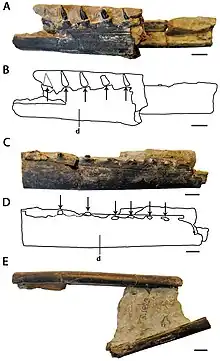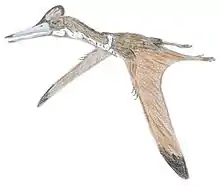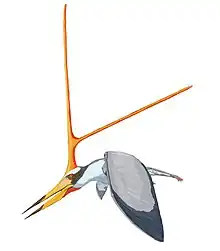Serradraco
Serradraco is a genus of Early Cretaceous pterodactyloid pterosaur from the Valanginian aged Tunbridge Wells Sand Formation in England. Named by Rigal et al. in 2018 with the description of a second specimen, it contains a single species, S. sagittirostris, which was formerly considered a species of Lonchodectes, L. sagittirostris.[1] In 2020, Averianov suggested it did not belong in Lonchodectidae.[2]
| Serradraco Temporal range: Early Cretaceous, | |
|---|---|
 | |
| Holotype jaw fragment in multiple views | |
| Scientific classification | |
| Domain: | Eukaryota |
| Kingdom: | Animalia |
| Phylum: | Chordata |
| Order: | †Pterosauria |
| Suborder: | †Pterodactyloidea |
| Clade: | †Ornithocheiromorpha |
| Genus: | †Serradraco Rigal et al., 2018 |
| Type species | |
| †Pterodactylus sagittirostris Owen, 1874 | |
| Species | |
| |
| Synonyms | |
| |
The second specimen, BEXHM 2015.18, consists of a small fragment of jaw with three teeth; six complete caudal vertebrae fused together and two fragmentary caudal vertebrae in articulation; a distal left ulna; a right proximal syncarpal; portions of a minimum of three phalanges and two indeterminate elements.[1]
Discovery and naming

In 1874, Richard Owen named a pair of lower jaws from the collection of Samuel Husband Beckles, found at St Leonards-on-Sea in Sussex, as a new species of Pterodactylus: Pterodactylus sagittirostris. The specific name means "arrowhead-snouted" in Latin, referring to the mandible profile in upper view.[3] In 1888, Edwin Tulley Newton, conforming to the soon to be published pterosaur systematics by Richard Lydekker, renamed the species into Ornithocheirus sagittirostris.[4] In July 1891, the British Museum (Natural History), the present Natural History Museum, bought the piece from the heirs of Beckles.
In 1914, Reginald Walter Hooley renamed the species into Lonchodectes sagittirostris.[5] In 1919 however, Gustav von Arthaber again considered it an Ornithocheirus sagittirostris,[6] which was confirmed by Peter Wellnhofer in 1978.[7] In 2001, David Unwin returned to the Lonchodectes sagittirostris designation.[8] In 2013, Taissa Rodrigues and Alexander Wilhelm Armin Kellner concluded that Lonchodectes sagittirostris lacked any distinguishing traits and was therefore a nomen dubium. In 2017, Stanislas Rigal, David Martill and Steven Sweetman disagreed with this and named a separate genus Serradraco, resulting in the new combination Serradraco sagittirostris. The type species of the genus is the original Pterodactylus sagittirostris. The generic name is a combination of the Latin serra, "saw" and draco, "dragon", referring to the saw-like upper profile of the lower jaws.[1]
Classification
In 2020, a phylogenetic analysis conducted by paleontologist Jordan Bestwick and colleagues recovered Serradraco as the sister taxon of Lonchodraco. Their cladogram is presented below.[9]
| Pterodactyloidea |
| ||||||||||||||||||||||||||||||||||||||||||||||||
References
- Rigal, S.; Martill, D. M.; Sweetman, S. C. (2017). "A new pterosaur specimen from the Upper Tunbridge Wells Sand Formation (Cretaceous, Valanginian) of southern England and a review of Lonchodectes sagittirostris (Owen 1874)". Geological Society, London, Special Publications: SP455.5. doi:10.1144/SP455.5.
- Averianov, A.O. (2020). "Taxonomy of the Lonchodectidae (Pterosauria, Pterodactyloidea)". Proceedings of the Zoological Institute RAS. 324 (1): 41–55. doi:10.31610/trudyzin/2020.324.1.41.
- Owen, R. 1874. "A Monograph on the Fossil Reptilia of the Mesozoic Formations. 1. Pterosauria." The Palaeontographical Society Monograph 27: 1–14
- Newton, E. T., 1888, "On the Skull, Brain, and Auditory Organ of a new species of Pterosaurian (Scaphognathus purdoni), from the Upper Lias near Whitby, Yorkshire", Philosophical Transactions of the Royal Society of London, v. 179, p. 503-537
- Hooley, R.W. 1914. "On the Ornithosaurian genus Ornithocheirus with a review of the specimens from the Cambridge Greensand in the Sedgwick Museum, Cambridge", Annals and Magazine of Natural History, series 8, 78: 529-557
- Arthaber, G. von, 1919, "Studien über Flugsaurier auf Grund der Bearbeitung des Wiener Exemplares von Dorygnathus banthensis Theod. sp.", Denkschriften der Akademie der Wissenschaften Wien, Mathematisch-naturwissenschaftliche Klasse, 97: 391–464
- Wellnhofer, P., 1978, Handbuch der Paläoherpetologie XIX. Pterosauria, Urban & Fischer, München
- Unwin, David M. 2001. "An overview of the pterosaur assemblage from the Cambridge Greensand (Cretaceous) of Eastern England". Mitteilungen as dem Museum für Naturkunde, Berlin, Geowissenschaftliche Reihe 4: 189–222
- Jordan Bestwick; David M. Unwin; Richard J. Butler; Mark A. Purnell (2020). "Dietary diversity and evolution of the earliest flying vertebrates revealed by dental microwear texture analysis". Nature Communications. 11 (1): Article number 5293. doi:10.1038/s41467-020-19022-2. PMC 7595196. PMID 33116130.












